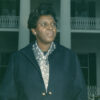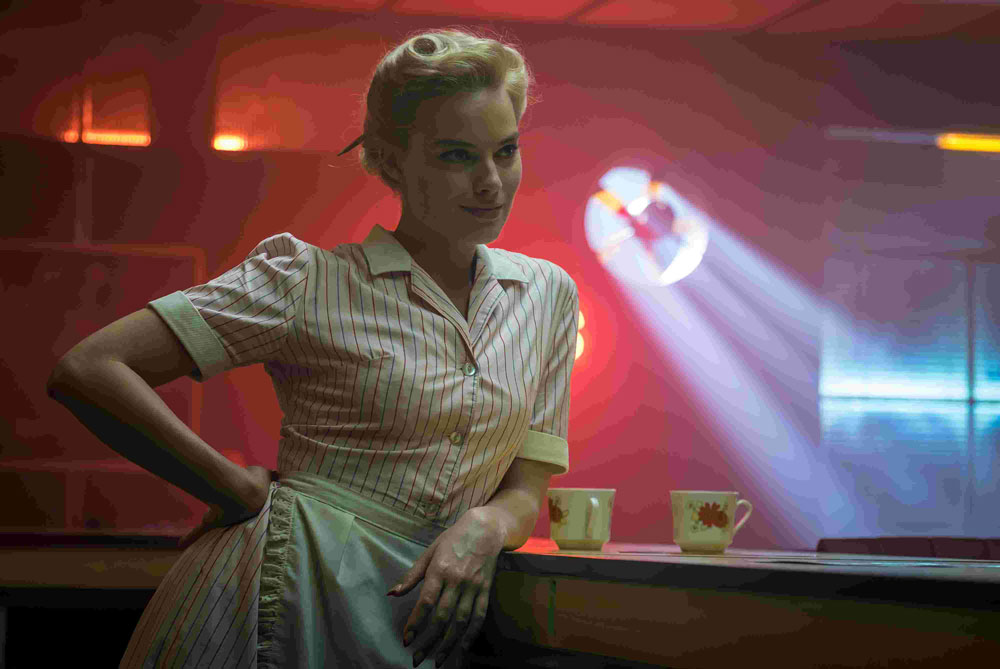“I have an unquenchable bloodlust for darkness and depravity,” Annie (Margot Robbie) tells a stranger (Simon Pegg) unabashedly who’s walked into the diner where she’s a waitress during the dead of night in “Terminal.” The man she comes to know as Bill has no physical luggage to speak of, but baggy eyes and rumpled skin to suggest he’s carrying quite a bit psychologically, and with little else to do on her late shift, she’s all ears for whatever he’d like to unburden himself of. As it turns out in Vaughn Stein’s twisty first feature, that is quite a bit as the shadowy train depot where the greasy spoon resides becomes a waystation for those who have reached a dead end in their lives, whether it’s a pair of hit men (Dexter Fletcher and Max Irons) booked for a job of which they have few details or a jowly night supervisor for the station (Mike Myers) whose lonely whistling of “Danny Boy” as he makes his rounds is a rare bit of human warmth in a place that’s oh so dark.
While the sizzle of neon brings light into the anonymous burgh where “Terminal” is set, it would be a disservice not to mention the additional charge that Robbie brings to it as well as Annie, who knows more than she lets on, but lets her curiosity pull back layers of bravado of men who probably don’t even know who they are anymore themselves. Often addressed as Sugar Plum and Bottle Blonde, she uses the fact that she too is unknown to her advantage, becoming a trojan horse dressed in form-fitting couture, even in her waitress outfit, out to expose all who underestimate her. And as intent as she is in tearing things apart, Stein, in his directorial debut after years of serving as an assistant director on blockbusters such as “World War Z,” creates a strange yet cohesive world for Annie to operate inside, evoking the Weimar Republic as if it were populated by knockabout hoods from the director’s native England.
Although the temptation isn’t to say too much about “Terminal” to keeps its surprises under wraps, Stein recently hopped on the phone to talk about the film’s myriad influences, the preparation for his feature debut that came with serving as an assistant director for so long and working with Robbie and Myers on their wild performances.
“Terminal” was the unhealthy love child of three things that wrestled around in my head — film noir, which I’d always loved since I fell in love with film, and the evolution of film noir [to] sci-fi noir, neo-noir and the hard-boiled noir – that appealed to my fascination with the darkness. Then I love dystopian cinema and literature and what a dystopia can give you in terms of a canvas for a story and I had this idea of bending the palette and the aesthetic of graphic novels into it and utilizing the dark fairy tale as a narrative tool.
You throw in another element, which is British slang from the early 20th century. With the different implications of time that are in the mix with each of those styles, how did that fit into the mix for you?
I loved the idea of giving the dialogue a kind of timeless, anachronistic feel. I wanted to draw from that old Cockney, East London feel. There’s a musical, Vaudeville [quality to the language] of the 1920s and ‘30s, especially with the gangsters and their bickering double act. I came up through theater and that’s obviously got a great and rich tradition in London-centric dialogue, but more than anything I think I wanted to draw on that feel of the classic noir dialogue that drips with cool and swagger. If you look at the Bogart and Bacall films or films that set the tone [with] noir, the characters had this amazing, effortless confidence with their dialogue and I really wanted to give that a British sensitivity, but retain that cool and danger, and that was a big thing for me to make them sound unique.
Margot Robbie isn’t only your lead actress, but also a producer on the film. What was it like having her as a full-on creative partner?
It was one of the great honors of my career. She’s a very close friend and she’s incredibly intelligent, so to be able to sit there for hours and weeks on end and hone in and sharpen this character, it was close to my heart. It was the very first character that I conceived in the story and she just took it and made it her own. [Annie is] a kaleidoscopic, mercurial character. She’s all things to all men. She can change at the drop of a hat and she embodies it brilliantly. It was an absolute pleasure to work with her and to watch her bring it to life.

For me, the linchpin of the story was [Annie]. The initial idea was to have this kooky, demonic female protagonist who was able to use her wiles to ensnare all of these men who had wronged her to populate the world and then it was very much chicken and egg. Annie arrived fully formed in my mind, and then the other characters quickly sprung up around her. I knew I wanted to embrace the noir archetype, like [Martin] McDonagh and [Quentin] Tarantino reference and homage so beautifully in their work, so I knew I wanted to do something in the narrative involving gangsters. And then there’s Bill, the terminally ill teacher, that actually came from a long-held desire – I had to write that conversation between this waitress and this guy in an all-night cafe in the middle of a station in the dead of night. It’s that amazing pleasure of writing [where] once you have an idea that you’re really confident in, all these other ideas start springing up around it.
Mike Myers seems like a particularly inspired choice to play the train depot commissioner – and it’s his first live-action film role in almost a decade. How did he come into consideration for this?
He was just astonishing. An amazing guy to work with, just a pleasure and a privilege. Margot and I had always wanted someone special for this kind of eccentric, quirky character and the producers and I thought, “Well, let’s go for something totally batshit crazy.” Mike Myers’ name came up during a chat, and we just all looked at each other and smiled and thought, “He’s never going to do it. He’s never going to take a small indie film like this.” We sent him the script on a wild hair and three days later, he read it. He asked to speak to me and we spoke for four hours, the first time we spoke and it was one of the great privileges of my life. To have your script read by a legend like that is one thing, and then for him to say, “Look, I love it. I want to come onboard and to have already done hours’ worth of background homework himself on the character and what he wanted to do with it was incredible. He engaged in the whole silhouette of the character as he calls it – the costume, the prosthetics, the look, the feel. It was amazing. An amazing, amazing thing to be part of.

Budapest is an astonishing city. It’s got a dichotomy of the former Austro-Hungary empire that clashes with the brutalist architecture of the USSR, so there’s a real sense of faded grandeur rubbing up against totalitarian buildings. That was what I had in mind when I conceived the story and when I got to Budapest, we were just looking around like, “Oh my God, it’s all here.” Again, it’s amazing work from Richard Bullock and Christopher Ross, the cinematographer and designer. What we wanted to do was take this incredible backdrop and make it our own. We were location-led almost entirely — we would build our sets into locations. There were things that we shot almost as they were because they were so perfect, but we built the cafe actually inside the train station that we shot, and we built the playground apartment [where the gangsters reside], as we called it, in a turn-of-the-century Hungarian building which was perfect for it. And then the red light district we put into a courtyard in the center of Budapest, which had that decaying, fading grandeur we were after. We knew we were onto a winner because in our last week of shooting, “Blade Runner 2049” were [following us] everywhere we were shooting, which was a very exciting moment for us.
You’re actually accustomed to big blockbuster productions like that with your work as an assistant director. Did your knowledge from those films help you create that bigger feel on a smaller production?
Absolutely. Having served my time practically was a huge help for me. What was so important to us was maximizing what we had, wherever we could making any weaknesses we had financially our strengths creatively. We had certain pieces of camera equipment for a few days and we rigorously rehearsed the set-piece shots we needed to see, so when we got there on the day, we were able to execute them really quickly. We could only afford two days with a 50’ technocrane, so we shot it as hard and fast as we possibly could because we knew that we wanted the scope and scale of a huge, epic, sweeping crane shot. Things like that are all about preparation and being an AD taught me that massively and you also have to leave room for those bubbles of inspiration that come up on set, those moments of creative genius that cast and crew have. But when you’ve got a finite budget and lofty ambitions, you need to be precise in your execution.

My wife is the art director on the film and there were a few days when she and I would get into the car at the end of the day and just kind of look at each other, covered in dust and sweat, like, “That was a long night.” [laughs] When we shot the scene on the metro, the metro was running at six o’clock in the morning, and we had to be out by four and we had a two-and-half-page scene to shoot. We were told there were no trains coming through, and unfortunately, there were no normal trains coming through, but we had all of these huge freight trains coming through like every 20 minutes that we’d just watch our time ticking away. It was terrifying. We also had nesting birds at one of our locations and every day, you’re running around trying to make your day and trying to shoot intense dialogue scenes and these fucking birds start chirping. It went on for about a half-an-hour every day that we were there. So that was pretty intense, but overall, it was an amazing, amazing set to work on. It was incredibly collaborative and all of these amazing people pouring their heart and soul into the film. Making a film of any budget, of any size or any scope or any scale is incredibly hard, but it’s also a privilege. I love making films and for all of the stress and heartache, you get to collaborate in one of the most amazing environments that anyone could ever work in.
“Terminal” opens on May 11th in Los Angeles at the Monica Film Center and in New York at the AMC Empire 25.





